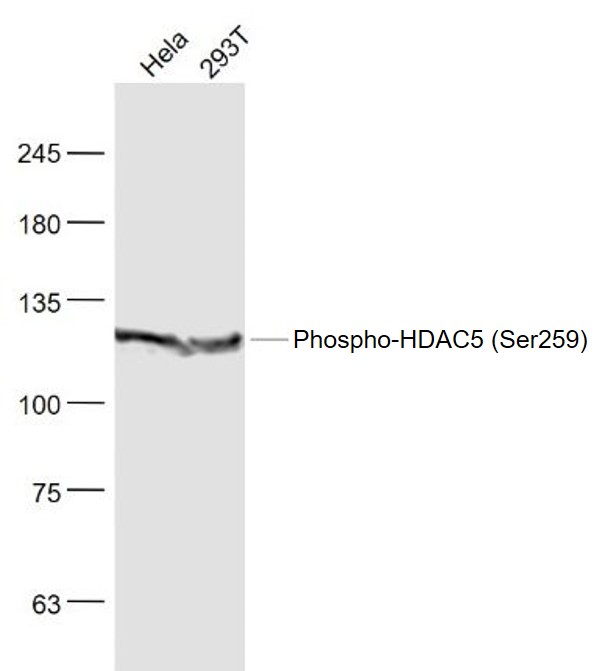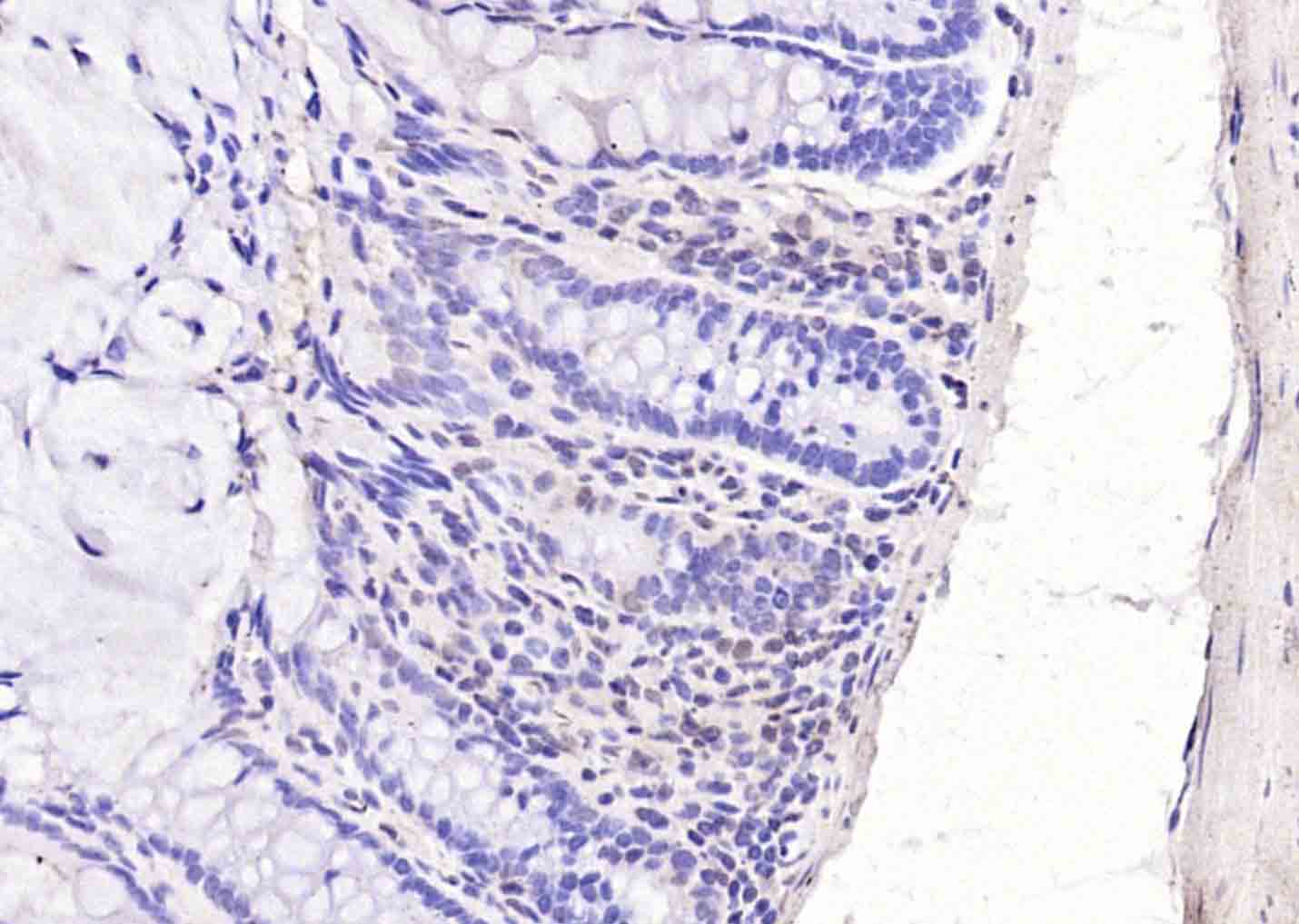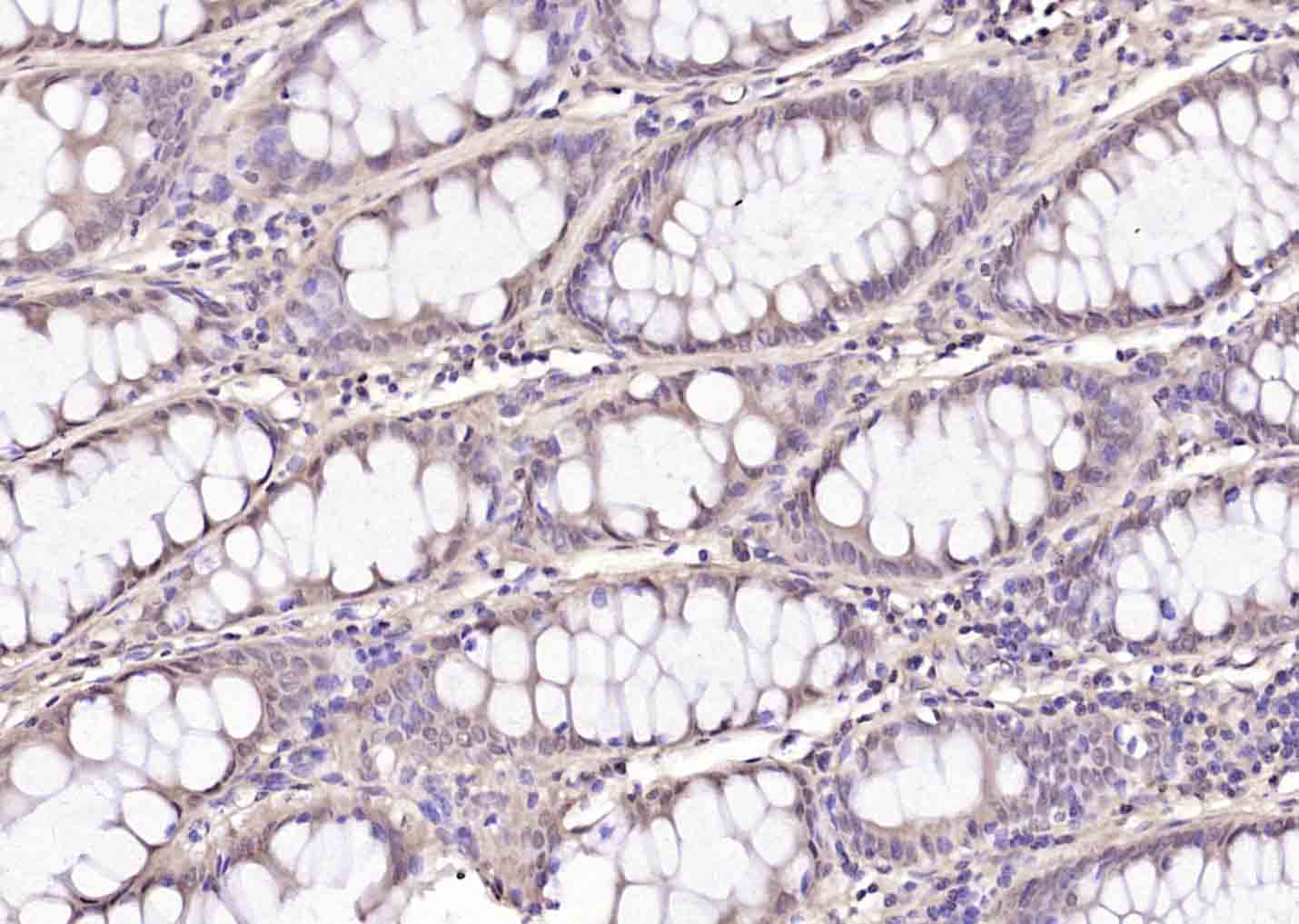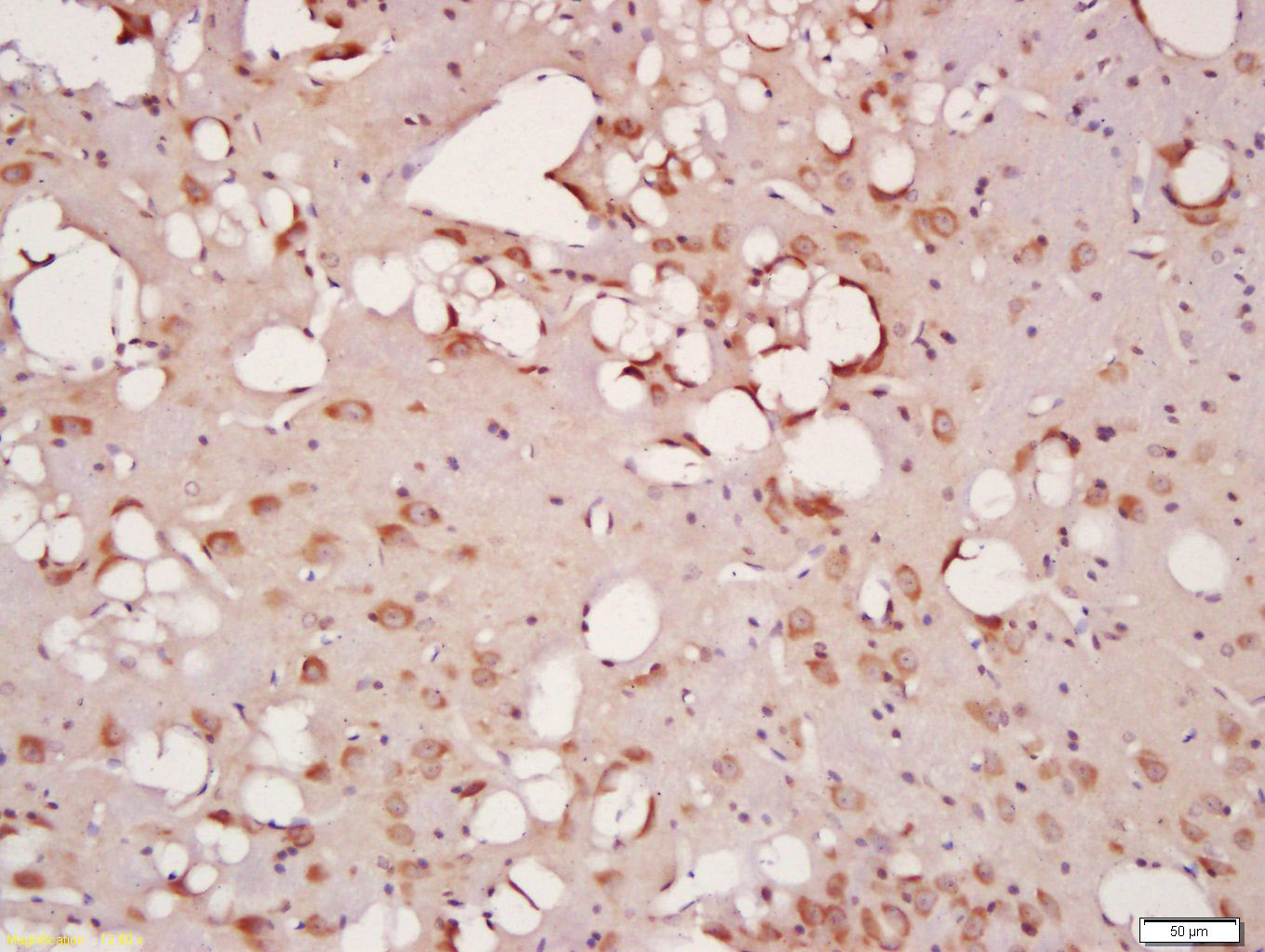
Rabbit Anti-Phospho-HDAC5 (Ser259)antibody
HDAC5 (phospho S259); p-HDAC5 (phospho S259); HDAC5(Phospho-Ser259); HDAC5(Phospho-S259); p-HDAC5(Ser259); p-HDAC5(S259); HD 5; HD5; HDAC 5; Histone deacetylase 5; KIAA0600; NY CO 9; Antigen NY CO 9; FLJ90614; HDAC5_HUMAN; Antigen NY-CO-9.
View History [Clear]
Details
Product Name Phospho-HDAC5 (Ser259) Chinese Name 磷酸化组蛋白去乙酰化酶5抗体 Alias HDAC5 (phospho S259); p-HDAC5 (phospho S259); HDAC5(Phospho-Ser259); HDAC5(Phospho-S259); p-HDAC5(Ser259); p-HDAC5(S259); HD 5; HD5; HDAC 5; Histone deacetylase 5; KIAA0600; NY CO 9; Antigen NY CO 9; FLJ90614; HDAC5_HUMAN; Antigen NY-CO-9. Product Type Phosphorylated anti Research Area Tumour Cell biology Neurobiology Signal transduction Apoptosis Immunogen Species Rabbit Clonality Polyclonal React Species Human, Mouse, Rat, (predicted: Dog, Pig, Cow, Horse, Rabbit, Sheep, ) Applications WB=1:500-2000 ELISA=1:5000-10000 IHC-P=1:100-500 IHC-F=1:100-500 ICC=1:100-500 IF=1:100-500 (Paraffin sections need antigen repair)
not yet tested in other applications.
optimal dilutions/concentrations should be determined by the end user.Theoretical molecular weight 123kDa Cellular localization The nucleus cytoplasmic Form Liquid Concentration 1mg/ml immunogen KLH conjugated synthesised phosphopeptide derived from human HDAC5 around the phosphorylation site of Ser259 : TA(p-S)EP Lsotype IgG Purification affinity purified by Protein A Buffer Solution 0.01M TBS(pH7.4) with 1% BSA, 0.03% Proclin300 and 50% Glycerol. Storage Shipped at 4℃. Store at -20 °C for one year. Avoid repeated freeze/thaw cycles. Attention This product as supplied is intended for research use only, not for use in human, therapeutic or diagnostic applications. PubMed PubMed Product Detail Histones play a critical role in transcriptional regulation, cell cycle progression, and developmental events. Histone acetylation/deacetylation alters chromosome structure and affects transcription factor access to DNA. The protein encoded by this gene belongs to the class II histone deacetylase/acuc/apha family. It possesses histone deacetylase activity and represses transcription when tethered to a promoter. It coimmunoprecipitates only with HDAC3 family member and might form multicomplex proteins. It also interacts with myocyte enhancer factor-2 (MEF2) proteins, resulting in repression of MEF2-dependent genes. This gene is thought to be associated with colon cancer. Two transcript variants encoding different isoforms have been found for this gene. [provided by RefSeq, Jul 2008].
Function:
Responsible for the deacetylation of lysine residues on the N-terminal part of the core histones (H2A, H2B, H3 and H4). Histone deacetylation gives a tag for epigenetic repression and plays an important role in transcriptional regulation, cell cycle progression and developmental events. Histone deacetylases act via the formation of large multiprotein complexes. Involved in muscle maturation by repressing transcription of myocyte enhancer MEF2C. During muscle differentiation, it shuttles into the cytoplasm, allowing the expression of myocyte enhancer factors.
Subunit:
Interacts with AHRR. Interacts with BAHD1, BCOR, HDAC7, HDAC9, CTBP1, MEF2C, NCOR2, NRIP1, PHB2 and a 14-3-3 chaperone protein. Interacts with KDM5B. Interacts with MYOC. Interacts with GRK5. Interacts with DDIT3/CHOP.
Subcellular Location:
Nucleus. Cytoplasm. Note=Shuttles between the nucleus and the cytoplasm. In muscle cells, it shuttles into the cytoplasm during myocyte differentiation. The export to cytoplasm depends on the interaction with a 14-3-3 chaperone protein and is due to its phosphorylation at Ser-259 and Ser-498 by AMPK, CaMK1 and SIK1.
Tissue Specificity:
Ubiquitous.
Post-translational modifications:
Phosphorylated by AMPK, CaMK1, SIK1 and PRKD1 at Ser-259 and Ser-498. The phosphorylation is required for the export to the cytoplasm and inhibition. Phosphorylated by the PKC kinases PKN1 and PKN2, impairing nuclear import. Phosphorylated by GRK5, leading to nuclear export of HDAC5 and allowing MEF2-mediated transcription.
Ubiquitinated. Polyubiquitination however does not lead to its degradation.
Similarity:
Belongs to the histone deacetylase family. HD type 2 subfamily.
SWISS:
Q9UQL6
Gene ID:
10014
Database links:Entrez Gene: 10014 Human
Entrez Gene: 15184 Mouse
Omim: 605315 Human
SwissProt: Q9UQL6 Human
SwissProt: Q9Z2V6 Mouse
Unigene: 438782 Human
Unigene: 22665 Mouse
Product Picture
Hela(Human) Cell Lysate at 30 ug
293T(Human) Cell Lysate at 30 ug
Primary: Anti- Phospho-HDAC5 (Ser259) (SL10326R) at 1/1000 dilution
Secondary: IRDye800CW Goat Anti-Rabbit IgG at 1/20000 dilution
Predicted band size: 119 kD
Observed band size: 119 kD
Paraformaldehyde-fixed, paraffin embedded (mouse colon ); Antigen retrieval by boiling in sodium citrate buffer (pH6.0) for 15min; Block endogenous peroxidase by 3% hydrogen peroxide for 20 minutes; Blocking buffer (normal goat serum) at 37°C for 30min; Antibody incubation with (Phospho-HDAC5 (Ser259)) Polyclonal Antibody, Unconjugated (SL10326R) at 1:200 overnight at 4°C, followed by operating according to SP Kit(Rabbit) (sp-0023) instructionsand DAB staining.Paraformaldehyde-fixed, paraffin embedded (human colon carcinoma); Antigen retrieval by boiling in sodium citrate buffer (pH6.0) for 15min; Block endogenous peroxidase by 3% hydrogen peroxide for 20 minutes; Blocking buffer (normal goat serum) at 37°C for 30min; Antibody incubation with (Phospho-HDAC5 (Ser259)) Polyclonal Antibody, Unconjugated (SL10326R) at 1:200 overnight at 4°C, followed by operating according to SP Kit(Rabbit) (sp-0023) instructionsand DAB staining.Tissue/cell: rat brain tissue; 4% Paraformaldehyde-fixed and paraffin-embedded;
Antigen retrieval: citrate buffer ( 0.01M, pH 6.0 ), Boiling bathing for 15min; Block endogenous peroxidase by 3% Hydrogen peroxide for 30min; Blocking buffer (normal goat serum,C-0005) at 37℃ for 20 min;
Incubation: Anti-Phospho-HDAC5 (Ser259) Polyclonal Antibody, Unconjugated(SL10326R) 1:200, overnight at 4°C, followed by conjugation to the secondary antibody(SP-0023) and DAB(C-0010) staining
Bought notes(bought amounts latest0)
No one bought this product
User Comment(Total0User Comment Num)
- No comment






 +86 571 56623320
+86 571 56623320
 +86 18668110335
+86 18668110335

